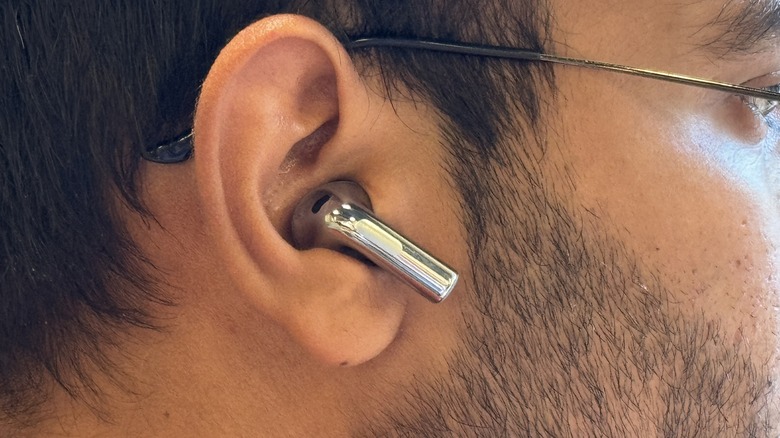
Nadeem Sarwar/SlashGear
EDITORS’ RATING : 8 / 10
- Pleasant bass-heavy sound output
- Touch and tap inputs work reliably
- Noise cancellation is impressive for the class
- Rewarding benefits for OnePlus users
- Priced well for the package
- Transparency mode could be better
- Features locked to OnePlus ecosystem
- 3D audio with added bass can be shrill
- Blue paintjob is a bit over the top
- Hi-Res mode toggling is irksome
OnePlus continues to expand its product ecosystem at a rapid pace, diversifying it across three core price spectrums that each stand out with the niceties available on the table. The latest offspring of that strategy is the OnePlus Buds, which sit below the premium OnePlus Buds Pro 2 and the affordable Nord Buds 2. The biggest sell of these earbuds is that they bring top-end audio tricks like noise cancellation and transparency mode to the masses.
They have the looks of premium headphones and offer plenty of thoughtful features that you won’t often come across for rival products in the same price bracket. Of course, there are a few omissions, but the OnePlus Buds 3 more than make up for it with other perks. At an asking price of $100, the overall package here is quite compelling, and if you happen to be a OnePlus smartphone user, these should sit at the top of your list.
OnePlus provided a pair of Buds 3 for the purposes of this review.
Good looks, great feel

Nadeem Sarwar/SlashGear
The OnePlus Buds 3 take inspiration from the OnePlus Buds Pro 2, from the earbuds styling to the shape of the charging case itself. But instead of going with a two-tone look of the Pro trim, the new OnePlus earbuds take a more minimalist approach. The only aspect shying away from the lustrous paint job is the pill-shaped touch-sensitive area. We got the Splendid Blue option, but OnePlus offers them in a Metallic Grey shade, as well.
These earbuds are light and their angled profile ensures a more secure fit so that they don’t fall off. Our reviewer went for morning runs and didn’t encounter any instances where there was concern that the earbuds would slip out unexpectedly. It also came as an added assurance that the OnePlus Buds 3 have IP55-level dust and water resistance, so sweat exposure was never a concern for me. The overall build is par for the price, and there are no red flags here.
You get multiple ear tip sizes to get the tightest ear canal seal depending upon the unique ear shape. OnePlus has put some engineering wizardry in this department to ensure a better listening experience. The company calls it Audio ID 2.0, which combines leakage compensation, ear canal sensing, and personalized sound perception, to deliver more personalized audio output. The first element in this system relies on the mic to check for sonic leakage and accordingly uses the data to tweak the output.
Pleasant audio work

Nadeem Sarwar/SlashGear
The raw audio output of the OnePlus Buds 3 serves bright treble, cleans mids, and most importantly, a well-above-its-price bass output. The coaxial dynamic dual driver system, which is a combination of a 10.4 woofer and a 6mm tweeter, targets hi-res music playback with support for the LHDC 5.0 codec. That essentially translates to a claimed peak output of 96KHz sample rate and 24-bit depth. It’s not quite lossless, but still far better than the CD quality standard.
To be fair, one needs a DAC and a higher sampling rate to differentiate between standard and hi-res music. But to its credit, the OnePlus Buds 3 sound really good, even though it was hard to discern the raw audio output with the Hi-Res mode enabled, and the same applied while switching between High Quality and Lossless presets on Apple Music.
OnePlus claims that LHDC 5.0 reaches a peak bit rate of 1Mbps, which is about four times as high as what Apple calls «high quality» for its AAC playback standards. So technically, the OnePlus Buds 3 can handle higher quality music streams, but feeling a tangible difference would take some effort here.
On the more realistic side of things, even with the volume raised to its peak, there is little distortion to be seen and the music profile never wades into the unpleasant territory. Even when compared to earbuds that cost nearly twice or thrice as much, the OnePlus Buds 3 didn’t feel lacking to the same extent as the price gulf. Overall, the vanilla listening experience is clean and if you’re an EQ purist, you can create your custom listening profile, as well.
Really leaning into the bass

Nadeem Sarwar/SlashGear
OnePlus offers a system called Basswave, which the company says can amp up the bass output in songs without distorting the vocals or degrading the instrumental clarity. It worked surprisingly well. When the bass slider is maxed out, the bass output adds some discernible thump and directional aspect to it. Overall, if you are a fan of trap beats, especially tracks leaning more into the instrumental style, you will appreciate this feature.
We noticed that to get the best out of this feature, set the equalizer to the Bass profile in the Sound Master EQ, and then enabled the OnePlus 3D audio effect. OnePlus says that this 3D audio enhancement feature «creates an immersive sound environment,» and it does its job well. It gives a slightly more surrounded sound-style feel to an otherwise bi-directional planar sound output.
The best way to experience it is by listening to music with a smaller variety of frequencies, such as audio recordings of natural surroundings. For example, if you are listening to relaxing rain or abstract waterfall tracks, the 3D Audio effect creates a perceptible difference and adds more spatial depth to the listening experience. But it’s worth noting here that there doesn’t seem to be any head-tracking element to it, unlike Apple’s well-received Spatial Audio system.
Noise cancellation and ambience hiccups

Nadeem Sarwar/SlashGear
These $100 earbuds also offer a surprisingly good noise-cancellation experience. Even with the volume level set close to the 50% level, transparency mode was able to able to muffle, to a good extent, a rather hyper-energetic screaming kid right behind our reviewer’s cafe table. With the volume fully cranked up, the ANC mode was able to hide the traffic noise and our reviewer could only feel the faint sound of the car horns or the rumbling of heavy vehicles if they were close.
The transparency mode also does an admirable job, especially considering the asking price of these earbuds. We compared them to the Samsung Galaxy Buds Pro 2 and the Status Between ANC 3, and found the transparency mode to doing an admirable job. The OnePlus Buds 3 seemed a bit more liberal with the transparency approach and didn’t dynamically adjust the sound output from the drivers for ambient noise like the Samsung earbuds.
The most notable downside is that the OnePlus Buds 3 tend to take an aggressive approach to audio routing, which makes it somewhat difficult to make sense of the ambient noise, especially human conversations if the volume level is anything above the 50-60% mark. It’s not terrible by means, but it lays bare the tech stack and just how far a product team can shoot within a tight budget. Notably, when compared to the Status Audio Between ANC 3, which cost $250 and come with three drivers, the OnePlus Buds 3 fared much better at both transparency mode and noise cancellation.
Where the budget cuts become apparent

Nadeem Sarwar/SlashGear
Of course, there are some pitfalls, too. One of them is the lack the instrumental nuance seen on higher-end mainstream wireless earbuds such as the Samsung Galaxy Buds 2 Pro and Apple’s AirPods Pro. That became evident while listening to tracks such as Sarah Schachner’s «Legion of Doom,» which is a mix of opera symphonies, dramatically modulated vocals, and reverberating synths.
Compared to OnePlus Buds Pro 2, OnePlus Buds 3 sound more one-dimensional as they lean more on the side of delivering a bass-heavy output, meddling with the mids and highs in the process. It’s hard to directly notice this, but once compared against the OnePlus Buds Pro 2 or other earbuds of its ilk, their audio output immediately feels more refined with a wider soundstage, better depth, and tonal clarity.
At volumes above the 80% mark, some distortion is visible if the Basswave toggle is set to the max and 3D audio is enabled. The vocals sound noticeably shrill, as the drivers tend to enhance the sound levels while trying to emulate a multi-directional surround sound experience.
A few controversial caveats

Nadeem Sarwar/SlashGear
Once again, enabling or disabling the Hi-Res mode requires a full disconnect and fresh pairing with your phone. And just like its pricier Pro sibling, the OnePlus Buds 3 once again gatekeeps a few facilities and keeps them restricted to OnePlus phones. For example, you won’t find the Hi-Res streaming feature in the Hey Melody app, which is mandatory for all non-OnePlus phones. Likewise, the ability to tap on the earbuds to capture photos when the camera app is open to limited to OnePlus smartphones.
Moreover, there is no option to adjust the strength of the noise cancellation in the Hey Melody app. This facility is exclusive to OnePlus phones. However, our reviewer didn’t see any purpose in adjusting the strength of the noise cancellation, as switching between ANC and transparency mode serves two polar opposite situations, and there is no need to hit a middle ground to be fair.
Functional standouts

Nadeem Sarwar/SlashGear
OnePlus Buds 3 stand out not solely on the merits of audio quality, but also on the attention OnePlus paid to other functional aspects. Take for example the Golden Sound system, which essentially runs a noise tuning test to determine the unique shape of every person’s ear canal and accordingly adjusts the sound output. Google Fast Pair support takes the struggle out of the Bluetooth pairing chore, and multipoint support ensures that the earbuds can stay connected to two devices simultaneously.
The pinch control system on the OnePlus Buds Pro 2 was finicky, but the tap and swipe-based system implemented on the OnePlus Buds 3 is noticeably more reliable. Plus, you can customize these gestures for each side to your liking. However, the slide-based volume level adjustment could be a chore for people with thick fingertips. The triple mic system delivered an adequately clean calling experience that even works well while cycling. Still, if you’re wearing something like a winter cap, the person on the other hand will notice some muffled output.
OnePlus claims 10 hours of playback time on a single charge, while the figures dial down to 6.5 hours if noise cancellation is enabled. Those numbers held up well in real-life tests. On average we saw a 30% hit on the battery while listening to music at 90% volume levels with ANC activated, Hi-Res output enabled, and the streaming preset set to Lossless (24-bit/48KHz) on Apple Music. Further sweetening the deal is support for fast charging, which adds enough juice to the case for seven hours of music playback with just 10 minutes of plugged-in time.
Conclusion: A no-brainer sans a few regrets

Nadeem Sarwar/SlashGear
There’s a lot to like about the OnePlus Buds 3, even before we get to the pure audio performance here. Their build doesn’t give up their budget status and the touch controls are reliable, as well. The mics are of good quality, the fit won’t leave you with buyer’s regret, the battery life figures won’t give you charging anxiety, and the IP55-level water resistance is an added quality-of-life assurance. Then we have features like adaptive noise cancellation, Basswave, ambient mode, and 3D audio that really add to the value proposition. Being able to customize the tap and swipe gestures is a bonus, even though there’s a slight learning curve here.
On the less pleasing side of the shore, OnePlus’ deliberate attempt at gatekeeping certain features and keeping them exclusive to its own-brand phones is not really a consumer-first approach, even though it makes sense and all major players like Apple and Samsung love to do it. If you are a purist, you might also notice that entering too deep into the bass territory with 3D audio enabled can somewhat degrade the vocals.
Looking at the competition, you have options like Anker Soundcore Liberty 4NC, Jabra Elite 4, Samsung Galaxy Buds FE, and the 1More ComfoBuds Mini. But if you weigh the OnePlus Buds 3 against the aforesaid options, the OnePlus earbuds stand out with their nigh irresistible serving of an impressive audio output married with some neat practical tricks to go with it. Overall, they are a strong contender to lead the $100 budget earbuds class for the year ahead and won’t leave you having second thoughts about your investment.
OnePlus Buds 3 can be found in the OnePlus store online for approximately $100.